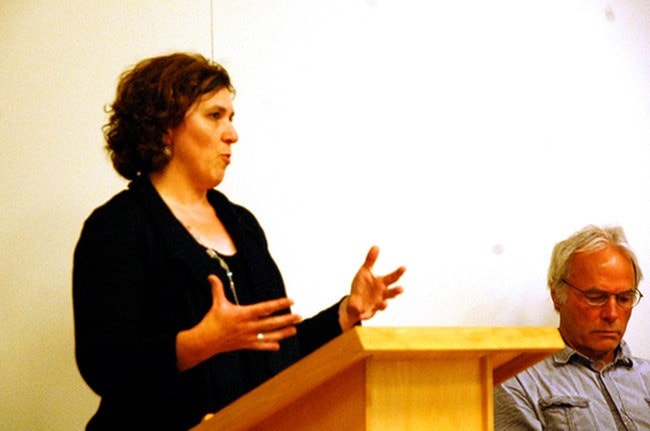With the Timber Supply Analysis in process, the big question about how the pine beetle will impact forest industries is still up in the air.
"It's too soon to tell [what the downfall will be]," said Agathe Bernard, Stewardship Officer with the Ministry of Forests, Lands, and Natural Resource Operations.
Bernard was at Houston council last Tuesday to talk about the Morice timber supply and the process of determining the allowable cut (amount of harvest allowed) for an area.
Bernard says they are in the middle of the Timber Supply Review process, and are making a Timber Supply Analysis based on gathered information and public input. After the analysis there will be another period for public comment before the decision is made about the annual allowable cut for the Morice TSA.
The current allowable cut in the Morice TSA, in place since February 2008, is 2,165,000 cubic metres per year, and of that volume no more than 550,000 cubic metres can be species other then pine.
Bernard says the key factors being considered in the Morice TSA are biodiversity, wildlife management, and the impact of any potential land base changes. The other major consideration is conserving timber for future harvest.
Bernard says that the mountain pine beetle killed 32 million cubic metres of pine in the Morice TSA from 2000 to 2012.
Just under 12 million cubic metres of that dead pine was harvested between 2005 and 2012, she said.
Most of the pine was killed before 2008, so most of those trees have been dead for five years now, and they estimate that after 15 years those trees will be no longer worth harvesting.
"So when the analysis happens, in the first five years, from 2013 to 2018, the dead pine will be prioritized for harvest, because again, it's got a shelf life and it's not going to be good forever," she said.
The Chief Forester has set a limit on the amount of non-pine that could be harvested, but Bernard says mills have been over-harvesting the non-pine for the past three years.
"There is 1.2 million cubic metres of non-pine that was over-harvested in the past three years alone," she said.
"What that means for the timber supply we don't know yet. That's part of the analysis and will be looked at very closely," she said.
Bernard says the two goals of the Timber Supply Review (TSR) are (1) to identify all the economic, environmental and social information that reflects current forest management practice, and (2) to identify all the First Nations and public concerns about the timber supply.
All of that is to give the Chief Forester the information he needs to consider when he decides the allowable cut, Bernard said.
She says there are five steps to the process:
(1) They gather information and get an inventory of the forests (how much wood there is, what species, where it's located, how fast it grows, etc.). That information goes into a data package.
(2) The data package goes up for public review and comment for 60 days. For the current Morice TSR, that step was July to September 2013.
(3) The Timber Supply Analysis is made, which predicts the amount of wood that can be harvested in the next 250 years. It also looks at the uncertainties and what would happen if a mistake is made or if key factors changed. This is the step they are currently working on for the Morice TSR.
(4) An analysis report and public discussion paper is published for public review, with stakeholders invited to comment. Bernard says this step will happen by the new year.
"I cannot emphasize enough how important it is for the Chief Forester to get local input," Bernard said.
"It really helps him to assess what is important and to see the socio-economic impact of his decision and what it would mean for communities," she said, adding that they really hope to get comments from Houston foresters at that time.
(5) The information is compiled and the Chief Forester reviews it and makes a determination about the annual allowable cut for the timber supply area, which will happen in 2014 for the Morice area.
After the Chief Forester makes his determination, the Minister of Forests decides how much of that volume goes to which mills and licensees.
The whole process takes between 12 and 22 months, Bernard said.
Councillor Jonathan VanBarneveld asked what factors are considered in analyzing the impact of the final decision on a community.
Bernard says they consider things like the labour force, the main economic driver of a community, how many jobs are directly and indirectly linked to forestry, as well as the milling capacity and amount of wood brought in or out of the area to be milled.
They then use a formula to translate the cubic metres of harvest into the number of indirect and direct jobs, which will be available in the published paper for public comment this January.
